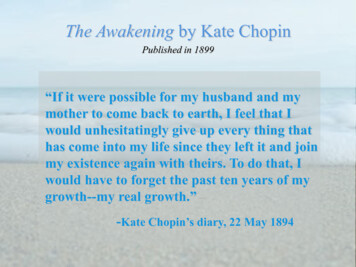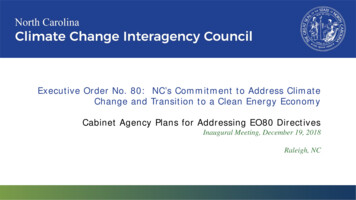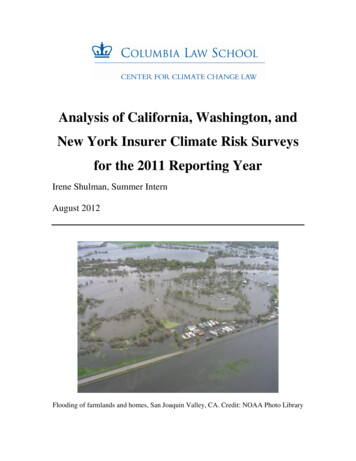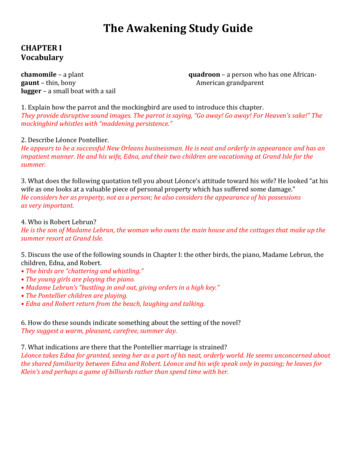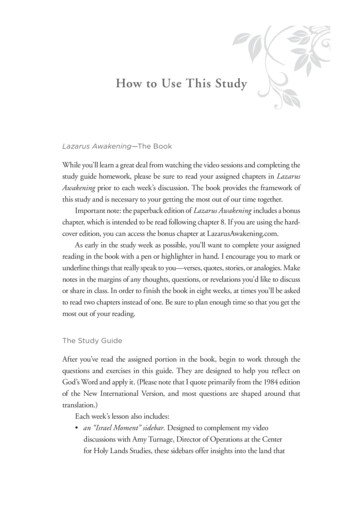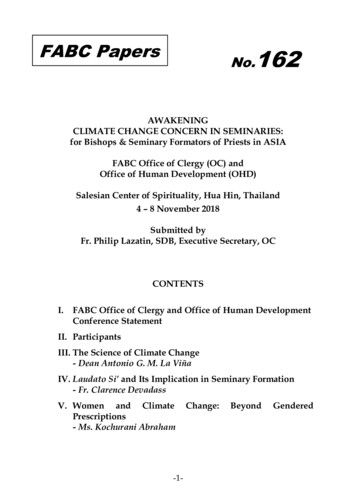
Transcription
FABC Papers162No.AWAKENINGCLIMATE CHANGE CONCERN IN SEMINARIES:for Bishops & Seminary Formators of Priests in ASIAFABC Office of Clergy (OC) andOffice of Human Development (OHD)Salesian Center of Spirituality, Hua Hin, Thailand4 – 8 November 2018Submitted byFr. Philip Lazatin, SDB, Executive Secretary, OCCONTENTSI.FABC Office of Clergy and Office of Human DevelopmentConference StatementII. ParticipantsIII. The Science of Climate Change- Dean Antonio G. M. La ViñaIV. Laudato Si’ and Its Implication in Seminary Formation- Fr. Clarence DevadassV. Women and ClimatePrescriptions- Ms. Kochurani Abraham-1-Change:BeyondGendered
I.FABC OFFICE OF CLERGY AND OFFICE OF HUMANDEVELOPMENT CONFERENCE STATEMENTDeeply conscious of her mandate to incarnate the mission of Christtoday, the Church recognizes that it is an integral part of her duty torespond to the climate emergency humanity faces today. With this inmind, the Federation of Asian Bishops Conferences (FABC) Office ofClergy and Office of Human Development at Salesian RetreatHouse, Hua Hin, Thailand focussed on the topic ‘AwakeningClimate Change Concern in Seminaries.’ We, the participants at thisConference consisting of 6 bishops, 26 priests, 1 religious brotherand 8 lay people coming from 10 different countries (Thailand,Bangladesh, India, Malaysia, Philippines, South Korea, Sri Lanka,Taiwan, Hongkong, Vietnam) as well as the engagement of socialmedia viewers realize that the priests of tomorrow will be keyagents in the struggle for a sustainable world. To equip them for thismission, we resolve to offer an integral formation to enable thedevelopment of new convictions, attitudes and behaviour patterns.We commit ourselves to introduce in Seminary formation a courseon Eco-theology combining the latest findings of science withChristian teaching and praxis. The duration of this course and itsintegration into the existing cycle of studies will be determined bylocal conditions.To foster an on-going ecological conversion, we resolve to inculcatein formators, seminarians and seminary staff a spirituality thatembraces a grateful contemplation of God’s creation. We will do thisby emphasizing our interconnectedness with creation throughliturgies, prayer exercises, eco-retreats and moments of quietcommunion with nature.A course on eco-theology would have no impact if it is notintegrated into the very fabric of seminary life. We resolve tocollaborate with all Seminary staff to introduce ecological concernsand reflections in other courses. We will also provide guidance sothat the seminarians are able to engage in ecological issues duringtheir weekend ministries. Above all, we commit ourselves topromoting a spirit of poverty and simple living in the seminary,starting with our own personal example. We commit to initiate a-2-
green audit in our seminary and making our seminaries more ecofriendly.To better understand the cry of the earth, it is necessary to also hearthe cry of the poor. Women, indigenous peoples and othervulnerable groups have suffered the most from climate disasters.Their stories of suffering and courage can contribute much to theformation of priests. We resolve to create opportunities wherebyseminarians can be immersed in the reality of the poor and learnfrom them. This could be in the form of short immersion experiencesor longer periods of residence among the poor. Additionally, we willalso create opportunities to engage in dialogue with persons of otherfaiths, learning how their faith traditions inspire their commitmentto care for our common home.The climate emergency that is around us is also a Kairos moment –through it we are being challenged to fundamentally re-examine thevery nature of our relationships and the existing structures ofseminary formation. Perhaps the Spirit is beckoning us towards acompletely new approach to formation. For the moment, we do notknow what this fully entails but we resolve to continue thisconversation in honesty and transparency. May the Lord who hasopened our hearts to hear the cry of the earth now fill us with thegrace to faithfully implement all that He is calling us to do.II. PARTICIPANTSThere were 40 participants from ten countries, viz.: Bangladesh,Hong Kong, India, Malaysia, Philippines, South Korea, Sri Lanka,Taiwan, Thailand, and Vietnam. Of the 40 participants there were 31clerics (6 bishops, 26 priests, 1 religious lay brother) and 7 laypersons. However, there were more than 40 persons who applied, afew cancelled their participation due to medical reasons or pastoralreasons. A significant fact to note is the presence of four experts ofEWTN (Eternal Word Television Network) and TV Maria whohelped us in video-documenting the lectures and proceedings, andwho made them available live by streaming on Facebook anddownloadable by Dropbox on internet. This significantly increasedthe audience and viewers from a handful of 40 who were physically-3-
present to thousands of virtual participants all over the world whoviewed the lectures by live streaming on Facebook.III. THE SCIENCE OF CLIMATE CHANGE- Dean Antonio G. M. La ViñaTime to declare a climate emergencyWith this column, I begin a new series on the climate emergency. Iwrite this first article from Songdo, South Korea where I amattending the Board meeting of the Green Climate Fund and I amrealizing that there is a lot of new information and important globaland Philippine developments on this issue. This series will shedlight on these.Last year, the, Intergovernmental Panel on Climate Change (IPCC),the world’s preeminent scientific body on climate change, publisheda report with a long and complex title: “Global Warming of 1.5 C.An IPCC Special Report on the impacts of global warming of 1.5 Cabove pre-industrial levels and related global greenhouse gasemission pathways, in the context of strengthening the globalresponse to the threat of climate change, sustainable development,and efforts to eradicate poverty.” With such a title, the message ofthe report could be lost in translation.That is a pity because the findings of the report are crystal clear. AsBrooking’s Institution’s Nathan Hultman pointed out in a blogposted right after the IPCC report was released: “An equallyaccurate but more evocative title could have been “We’re almost outof time.”“In essence, we only have until 2030 to transform the global economyto avoid the worst impacts of climate change by 2050. This is verydifferent from when I did a law dissertation on the subject for YaleLaw School in the early 1990 when the science was much moreuncertain and the projections of the worst scenarios were for the endof the 21st century or 2200 and thereabouts.Of course between the 1990s and the 2010s, we have seen how theearly science has underestimated in terms of timing and severity thearrival of the impacts of climate change. In the 1990s, whenever I-4-
talked about climate change, I always mentioned how one daytyphoons like Yolanda, Pablo, Sendong, Ondoy, etc. could devastateour islands and cities. But in my first presentations, because of thescientific information available then, I always said these storms werelike to happen later in the 21st Century or early in the 22nd Century.I was a hundred years off in my projection.Nowadays, in my climate change lectures, I point to our vulnerablecities, foremost of which are those in the Manila Bay region. I tell myusually younger audiences that I will not be surprised if within theirlifetimes, they would have to deal with major storm surges thatthreaten the reclaimed areas and Manila’s historic sites. When I givemy usual lecture to our young diplomats undergoing training ascadets at the Foreign Service Institute, I ask them to imaginethemselves or their colleagues one day trapped by floods and/orstorm surges, exacerbated by sea level rise in the old Department ofForeign Affairs building in Roxas Boulevard.In the context of the threat of climate change, all the efforts of MayorIsko Moreno to revive the glory of Old Manila will come to naught.Certainly, all proposed reclamation projects in the region should beabandoned as they will increase the threat for all of us.Given the magnitude of what the climate change impacts we arefacing, it is time now to declare a climate emergency. The globalcommunity should do that. The Philippine government must dothat. The city of Manila, all the cities of our metropolis, and all ourcoastal cities and provinces must do that.Among others, instead of withdrawing or minimizing ourdiplomatic engagement on climate change, we actually need to giveit more priority and emphasis. Our strong voice, effective for manyyears (including up to the 2015 Paris meeting, the last importantgathering of heads of state), is needed to push this important goal ofhaving the global community declare a climate change emergency.I would encourage Foreign Affairs Secretary Teddy Boy Locsin, aman I will always admire even when I sometimes disagree with him,to plan ahead for the 2020 Conference of the Parties of the UnitedNations Framework Convention on Climate Change. That is a-5-
critical conference if we want to push the agenda of climate justiceforward.A climate emergency declaration is also urgent for localgovernments.Among others, New York City, London, Sydney and a total of 722localities in 15 countries have already made this declaration of “animmediate emergency mobilization to restore a safe climate.” TheCity of Manila should join this cohort as a matter of priority.Indeed, we are faced with a climate crisis of immense dangers. Theclimate threat has been described as not just “dangerous”, or even“catastrophic”, but “existential” – “a threat that could annihilatemost people on earth.”The threat is not only to people, but to all life. Climate change, aspinned down by the recently released Global Assessment Report onBiodiversity and Ecosystem Services by the IntergovernmentalScience-Policy Platform on Biodiversity and Ecosystem Services(IPBES), accelerate the destruction of ecosystems and the extinctionof species. In that assessment, the authors conclude that a millionspecies face extinction and rank five direct drivers of that, withclimate change as the third biggest culprit following changes in landand sea use and direct exploitation of organisms and ranked higherthan pollution and invasive alien species.Time is running out to address the climate emergency, but actionsbeing done are not commensurate to what has to be done. Aspointed out by Jane Morton in Don’t Mention the Emergency: mergencydeclaration.org), this is because “vested interestsare running the biggest disinformation campaign in history”. Fossilfuel, mainly oil and coal interests, unfortunately have “a corruptinginfluence on politicians and the media and are prepared to spendmillions of dollars to block action”.Morton documents how climate scientists are pressured tounderstate the risks, threatened and harassed and risk losingresearch funding for making strong statements. She describes IPCCreports as tending towards reticence and caution, erring on the side-6-
of ‘least drama’, and downplaying the more extreme and moredamaging outcomes.”Having previously been Executive Director of the ManilaObservatory, a 150 year old scientific research institution that usedto be the weather bureau of the Philippines and is a leading climatechange science institution in Asia, I appreciate the need for peerreview and avoiding catastrophic language. Many of my colleagueshave doctorates in Physics and are trained in the scientific method.Although they are not activists, they do know that what we arestudying has serious consequences for human well-being andespecially for the poor.Morton quotes Kate Marvel, a climate scientist, who wroteeloquently that what we need to face climate change is not hope, butcourage.“I always end my talks on climate change with a message of hope.But I agree that such hope must be grounded in courage to changethings. Without courage, hope is false.”I agree with Hans Schellnhuber, founding director of the PotsdamInstitute for Climate Impact, who points out that humanity is “nowreaching the end-game.” Morton is right: “There is now not enoughtime for a long debate about whether the current climate trajectory isan emergency or can be addressed with gradual change. Theforecasts are compelling and the scenarios are devastating. It’s timeto move straight to the most important question of our times: how torestore a safe climate at emergency speed.”In the next column, I will write about climate change and poverty,summarizing and reflecting on a recently released Report of theSpecial Rapporteur on extreme poverty and human rights. This willbe followed by two columns on adaptation and mitigation solutionsthat can be done at the local, national, and global levels. Finally, Iwill write about what the climate emergency demands of our leaders– from national government officials, local leaders, and ourdiplomats.-7-
Climate emergency and the poorIn all my lectures on climate change, I always emphasize the doubleinjustice in climate change: the poorest countries and the poorestcommunities in all countries will suffer first and most from climatechange even as they have contributed the least to the anthropogenicgreenhouse gas emissions that causes climate change. Conversely,the richest countries and the wealthiest people in all countries willhave more options in dealing with climate change.This gross climate injustice and inequity will be exacerbated in theyears and decades to come, as made clear in a recent report by PhilipAlston, the United Nations Special Rapporteur on extreme povertyand human rights. That report, issued last June 25, concluded:“Climate change will have devastating consequences for people inpoverty. Even under the best-case scenario, hundreds of millionswill face food insecurity, forced migration, disease, and death.Climate change threatens the future of human rights and risksundoing the last fifty years of progress in development, globalhealth, and poverty reduction.”The Alston report, from which I lifted most of what I say in thiscolumn, does not mince words, outlining how climate change willintensify existing poverty and inequality: “It will have the mostsevere impacts in poor countries and regions, and the places poorpeople live and work. Developing countries will bear an estimated75-80 percent of the costs of climate change.”This is because poor people live in areas more vulnerable to climatechange, including in housing that is less resistant. The poor “loserelatively more when affected; have fewer resources to mitigate theeffects; and get less support from social safety nets or the financialsystem to prevent or recover from the impact.” For obvious reasons,the livelihoods and assets of the poor are more exposed. In addition,poor communities are “more vulnerable to natural disasters thatbring disease, crop failure, spikes in food prices, and death ordisability.”These observations are true in the Philippines. We have seen thepoor suffer the most in all our big disasters, including when Yolanda-8-
devastated the Visayas, Pablo destroyed huge areas of Mindanao,and Sendong killed thousands in Cagayan de Oro.Alston observes that climate change could end up undoing decadesof progress in development, global health, and poverty reduction.He notes: “Middle-class families, including in developed countries,are also being rendered poor. The World Bank estimates thatwithout immediate action, climate change could push 120 millionmore people into poverty by 2030—likely an underestimate, andrising in subsequent years. Eight hundred million in South Asiaalone live in climate hotspots and will see their living conditionsdecline sharply by 2050.”Quoting the most recent scientific studies, Alston points out that, at2 C degrees of warming, 100-400 million more people will be put atrisk of hunger and 1-2 billion more people may no longer haveadequate water. He also cites studies on how climate change couldresult in global crop yield losses of 30 percent by 2080, even withadaptation measures.The Alston report highlights public health impacts, which the poorwill bear disproportionately: “Between 2030 and 2050, it is expectedto cause approximately 250,000 additional deaths per year frommalnutrition, malaria, diarrhea, and heat stress. With people inpoverty largely uninsured, climate change will exacerbate healthshocks that already push 100 million into poverty every year.”Alston describes how poor people in poverty face serious threats oflosing their homes, highlighting how in 2050, climate change coulddisplace 140 million people in Sub-Saharan Africa, South Asia, andLatin America alone. He emphasized the impact of flooding andlandslides, weakening “already degraded infrastructure andhousing—especially for people living in unplanned or unservicedsettlements.” According to Alston, “2017 saw 18.8 million peopledisplaced due to disasters in 135 countries—almost twice thenumber displaced by conflict. Moreover, since 2000, “people in poorcountries have died from disasters at rates seven times higher thanin wealthy countries. Sadly, he points out, “authorities have ahistory of prioritizing wealthier areas for protection, furtherendangering people in poverty.”-9-
As I noted at the beginning of this article, what is particularly gallingabout climate change is the inequity and injustice that characterizesit. Alston documents this as well: “Perversely, the richest, who havethe greatest capacity to adapt and are responsible for and havebenefitted from the vast majority of greenhouse gas emissions, willbe the best placed to cope with climate change, while the poorest,who have contributed the least to emissions and have the leastcapacity to react, will be the most harmed. The poorest half of theworld’s population—3.5 billion people—is responsible for just 10percent of carbon emissions, while the richest 10 percent areresponsible for a full half. A person in the wealthiest 1 percent uses175 times more carbon than one in the bottom 10 percent.”Alston also cites data that illustrates how “climate change itself hasalready worsened global inequality and that the gap in per capitaincome between the richest and poorest countries is 25 percentagepoints larger than it would be without climate change.”In the face of these impacts, action has been wanting. According toAlston: “Somber speeches by government officials at regularconferences are not leading to meaningful action. Thirty years ofconventions appear to have done very little. From Toronto toNoordwijk to Rio to Kyoto to Paris, the language has beenremarkably similar as States continue to kick the can down the road.The essential elements of climate change were understood in the1970s, and scientists and advocates have been ringing alarm bells fordecades. Yet States have marched past every scientific warning andthreshold, and what was once considered catastrophic warming nowseems like a best-case scenario.”It’s not just governments that have failed us. Big business has beencomplicit, especially fossil fuel companies: “In 2015, the fossil fuelindustry and its products accounted for 91 percent of globalindustrial greenhouse emissions and 70 percent of all human-madeemissions.” It is an industry that has known for decades about theirresponsibility for rising CO2 levels and the likelihood that the risewould lead to catastrophic climate change. And yet, it took no actionto change its business model.-10-
According to the Alston report: “From 1988 to 2015, fossil fuelcompanies doubled their contribution to global warming, producingin 28 years the equivalent of their emissions in the prior 237 yearssince the Industrial Revolution. During that time, just 100 companiesproduced 71 percent of global greenhouse gas emissions.”Finally, the report concludes with constructive proposals on how tomove forward: “Addressing climate change will require afundamental shift in the global economy and how States havehistorically sought prosperity, decoupling improvements ineconomic well-being and poverty reduction from resource depletion,fossil fuel emissions, and waste production. This will entail radicaland systemic changes including incentives, pricing, regulation, andresource allocation, in order to disrupt unsustainable approachesand reflect environmental costs in entire economic subsystemsincluding energy, agriculture, manufacturing, construction, andtransportation.”We can still avert the worst impacts of climate change. The poor donot have to be sacrificed and thrown to the mercies of the stormsand droughts that are coming. But to succeed in this, we mustdeclare a climate emergency now – globally, nationally, and locally.Urgent climate emergency measuresThis is my third column on the climate emergency.In the first article, I summarized the latest scientific information onclimate change, which collectively point to the conclusion that whatwe are facing is a climate emergency. The familiar way of framingthe issue – that climate change is a long-term challenge and we stillhave the time to address it effectively - is no longer tenable. Climatechange is already here and it will get much worse, and the worstimpacts will be felt by 2050 or even earlier. In addition, we only have11 years from today – up to 2030 – to transform the global economyto avert the worst scenarios for 2020.In my column last Saturday, I wrote about the impacts of the climateemergency on the poor. Citing mainly a recent report on climatechange and poverty by Philip Alston, the United Nations SpecialRapporteur on extreme poverty and human rights, I highlighted-11-
how the climate emergency will exacerbate economic inequity andsocial injustice.In this column, citing extensively again from the Alston report andalso from a colleague from the World Resources Institute (WRI), Iwrite about the solutions. Truth be told, climate science might becomplex but what we need to do to mitigate and to adapt to climatechange does not require hard science.I endorse the view of Mr. Alston that addressing climate changeeffectively require a fundamental shift in the global economy. Itrequires rejecting the traditional way States have achievedprosperity, “decoupling improvements in economic well-being andpoverty reduction from resource depletion, fossil fuel emissions, andwaste production.” According to the Alston report, “This will entailradical and systemic changes including incentives, pricing,regulation, and resource allocation, in order to disrupt unsustainableapproaches and reflect environmental costs in entire economicsubsystems including energy, agriculture, manufacturing,construction, and transportation.”“Much of post-industrial poverty reduction and economic growthhas been based on unsustainable resource extraction andexploitation. Certain people and countries have gotten incrediblywealthy through emissions without paying for the costs to theenvironment and human health—costs borne disproportionately bypeople in poverty. Staying the course will not preserve growth in thelong term, but will be disastrous for the global economy and pullhundreds of millions into poverty. Climate action should not beviewed as an impediment to economic growth but as an impetus fordecoupling economic growth from emissions and resourceextraction, and a catalyst for a green economic transition, labourrights improvements, and poverty elimination efforts.Climate change will require deep structural changes in the worldeconomy. It is imperative this is done in a way that providesnecessary support, protects workers, creates good jobs, and isguided by international labour standards. A robust social safety netand a well-managed transition to a green economy will be the bestresponse to the unavoidable harms that climate change will bring.”-12-
There is no way around this need to transform the global economy.As WRI’s Kelly Levin put it when the 1.5 report of theIntergovernmental Panel on Climate Change came out last year:“While there have been examples of rapid change in specifictechnologies or sectors in the past, there is no precedent in ourdocumented history for the rate of change at the scale required forlimiting warming to 1.5 C. In other words, we have never beforewitnessed such widespread, rapid transitions, and they will need tobe made across energy, land, industrial, urban and other systems, aswell as across technologies and geographies.Alston points out that renewable energy will create jobs and energyefficient investments will lead to greater energy savings and feweremissions. He also emphasizes the positive impacts of climateadaption and a sustainable economy on healthcare costs andpreventing environmental degradation. It could “restore overusedand exhausted resources, increase food and water security, andreduce poverty and inequality.”The Alston report cites how twenty-three countries have succeededin decoupling economic growth from carbon emissions. Renewableenergy, carbon pricing, and green subsidies and jobs, are solideconomic strategies that work for the poor.But let’s be clear, while we know what we should be doing, it won’tbe easy getting these to happen. But what prevent us fromaddressing the climate emergency effectively are social and political,not technological or economic, barriers.According to Levin: “There’s no sugarcoating it. Keeping warmingto 1.5 C will be hard. Really hard. But the IPCC report also makes itclear that the world has the scientific understanding, thetechnological capacity and the financial means to tackle climatechange. Now what we need is the political will to precipitate theunprecedented concerted actions necessary to stabilize temperaturerise below 1.5 C.”Governments, the private sector, local governments andcommunities, families and individuals have roles to play. The youthhave a particular role to play.-13-
Governments must take the lead by declaring a global climateemergency and increasing their commitments in the ParisAgreement. According to Alston: “Climate change should be acatalyst for States to fulfil long ignored and overlooked economicand social rights, including to social security, water and sanitation,education, food, healthcare, housing, and decent work. Revenuefrom climate action including emissions control and taxrestructuring should be used to fund social protection programs toprotect those affected.”Developed countries and the big developing countries must still takethe lead. But middle income countries and the least developedcounties, including the most vulnerable, must also reduce emissions.The richer counties must increase their financial assistance todeveloping counties so that the latter can adapt better and contributemore to mitigate climate change.We should assign and send more, not less, diplomats to the annualclimate change negotiations. We should rejoin the Like MindedDeveloping Countries bloc and there carry the banner of climatejustice.We might want to revisit our climate governance system, based on aflawed design of a Climate Change Commission (CCC) headed bythe President. I have worked with all four of the Vice-Chairs of theCCC since it was established in 2010 and they have been dedicatedand committed but with a system designed to fail, they have had todeal with enormous challenges. I prefer a new department perhapscombined with our disaster resilience needs or with the currentenvironment department as a way forward.For sure, as Alston highlights it, companies can provide andimplement solutions to climate change, but he warns that anoverreliance on voluntary, private sector efforts would be wrong.According to Alston: “Climate change is a market failure, andvoluntary emissions reduction commitments will only go so far . . . .An over-reliance on the private sector could lead to a climateapartheid scenario in which the wealthy pay to escape overheating,hunger, and conflict, while the rest of the world is left to suffer.”-14-
Local governments must now take the lead in addressing the climatechange. Hundreds of local governments have now declared aclimate emergency. Young and progressive leaders lead the cities ofManila, Pasig, San Juan, Makati, Quezon City, Valenzuela, andDumaguete and the province of Dinagat Islands, among others.They should make this a priority and have their councils declare aclimate emergency, prioritizing climate change adaptation andmitigation measures.Finally, the youth have the most important role in what has to bedone to fight the climate emergency. I encourage and support theclimate strike movement inspired by Greta Thunberg of Sweden.Young people have the most at stake in the climate emergency. Theyalso have the energy and courage to insist on what has to be done.The climate emergency is the biggest challenge the world faces. ThePhilippines is going to be particularly hit by it. Working together, westill have time – not much yes, but enough – to avert the worst. Butwe have to start now.IV. LAUDATO SI’ AND ITS IMPLICATION IN SEMINARYFORMATION- Fr. Clarence DevadassAbstractProtection of the common home (environment) is no longer optional orsecondary to the Christian life. This care for the common home come from agenuine relationship with God who is the Creator of all things. Despite themany challenges and obstacles that one may face, the care for the common homeis an integral part of the human vocation and that living our vocation to beprotectors of God’s handiwork is essential to a life of virtue. For these reasonsthen, seminary formation must be geared towards the formation of futurepriests to be “men of communion” – with the God, self, other, and the cosmos.The topic of seminary formation is one that evokes differentsentiments in many people. It is a topic that has been worked on andcontinuously reworked since the Council of Trent in the 16thcentury. Over the years, not only the co
Climate Change Concern in Seminaries.' We, the participants at this Conference consisting of 6 bishops, 26 priests, 1 religious brother and 8 lay people coming from 10 different countries (Thailand, Bangladesh, India, Malaysia, Philippines, South Korea, Sri Lanka, Taiwan, Hongkong, Vietnam) as well as the engagement of social .

